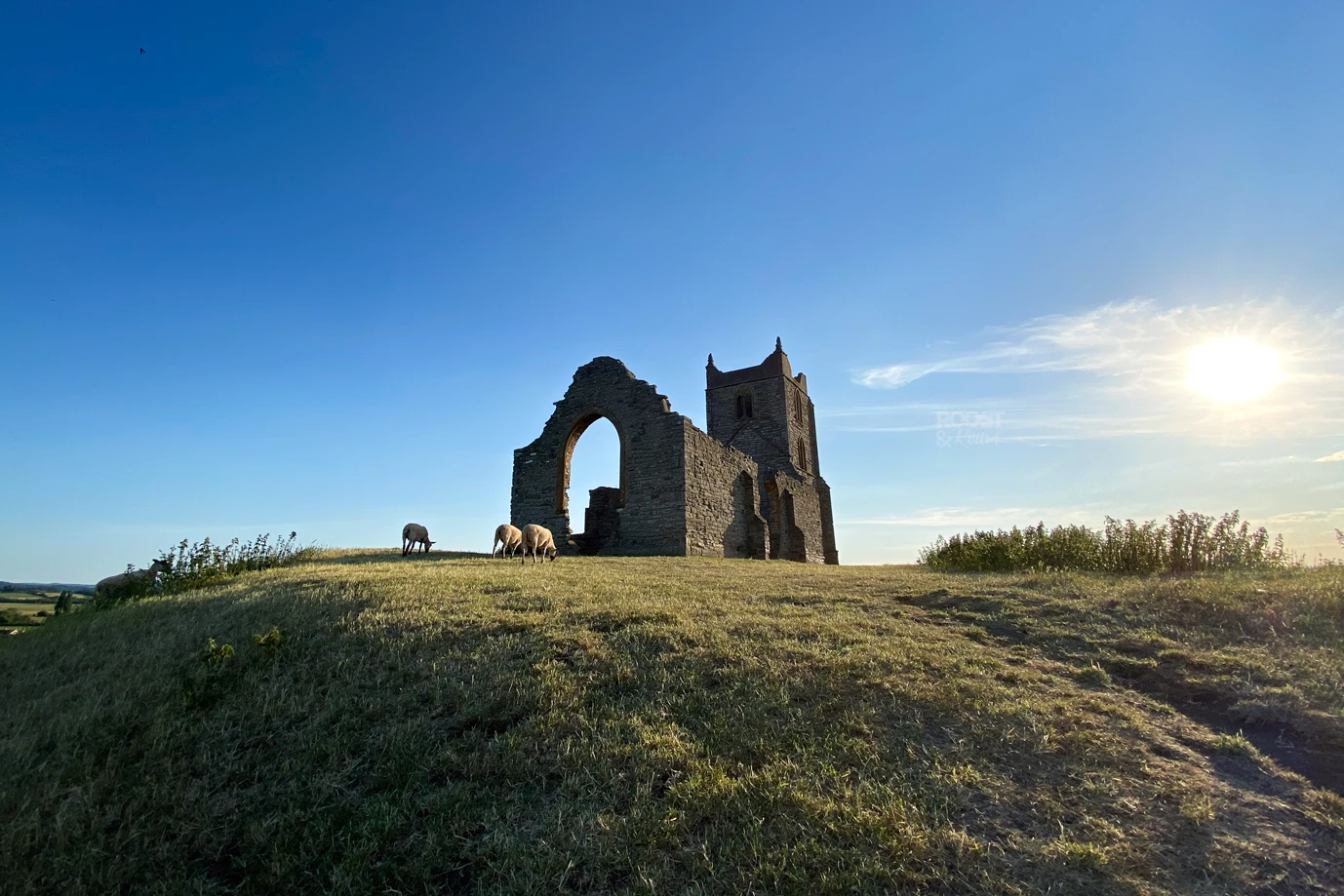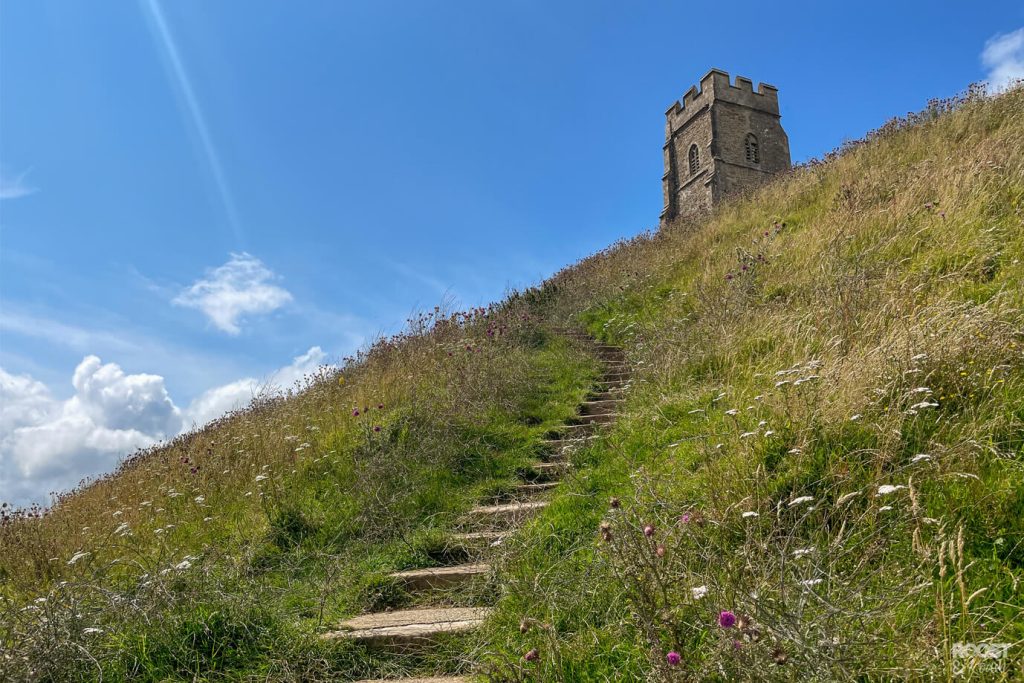Burrow Mump doesn’t seem to shine under the same spotlight as the world renown Glastonbury Tor. Yet this nearby, isolated historic church is a little more rugged, and offers uninterrupted views across the patchwork fields of the Somerset Levels. On a summers day you might find yourself surrounded by a flock of woolly sheep, and if the sky is clear, you’ll be able to spot Glastonbury Tor on the horizon.
So, if you’re holidaying in the South West of the UK, or perhaps just exploring Somerset in general. Then I suggest walking in King Alfred’s footsteps, and stepping back in time with a gentle hike up Burrow Mump.
Here’s a little bit of history about Burrow Mump, and why you should pay a visit sometime.
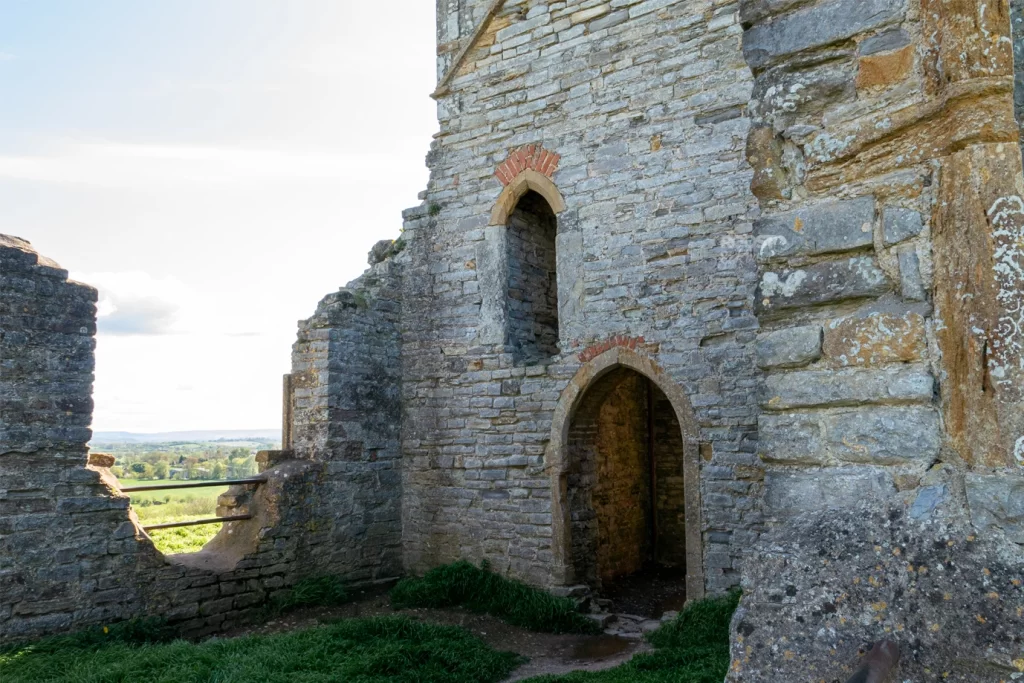
In this article...
Where is Burrow Mump?
Burrow Mump is in the small Somerset village of Burrowbridge, where it sits right beside the A361. You’ll find Burrow Mump roughly halfway between Taunton and the vibrant town of Glastonbury.
The address for Burrow Mump: A361, Burrowbridge, Bridgwater, TA7 0RB
Or use ///term.demoted.broadens to take you right to the carpark.
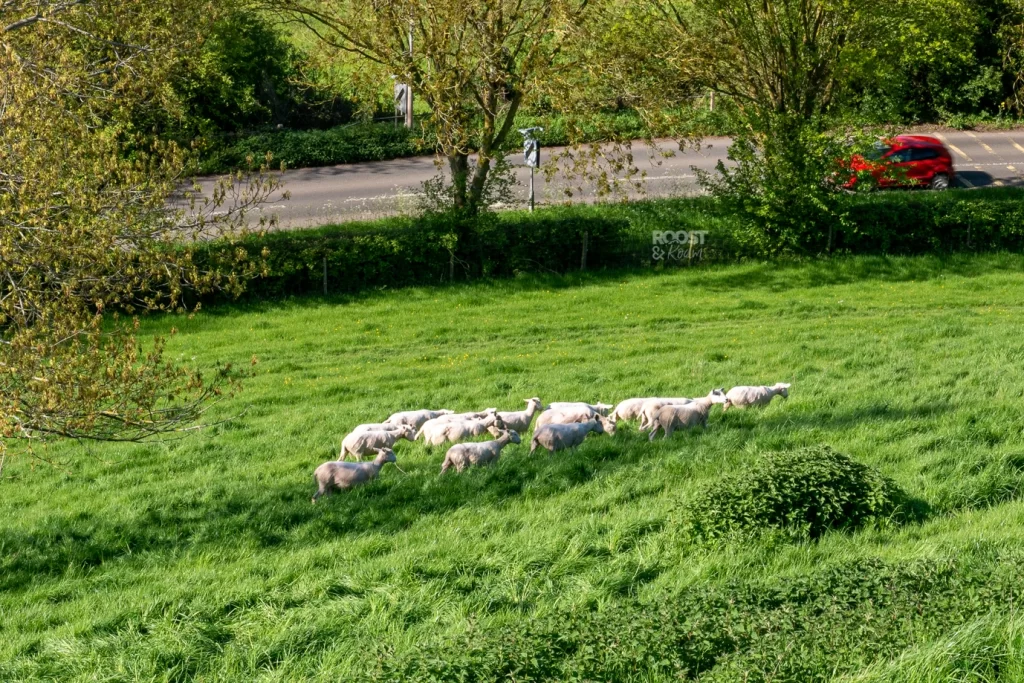
Whats the church ruin at Burrow Mump?
The St. Michaels Church ruin that stands today was constructed in 1793. Although, due to financial hardship the build was never finished. Quite sometime later in 1946, the church, along with the surrounding land was handed over to the National Trust. At which point it became a war memorial for over 11 thousand Somerset men and women who sadly lost their lives during World War II.
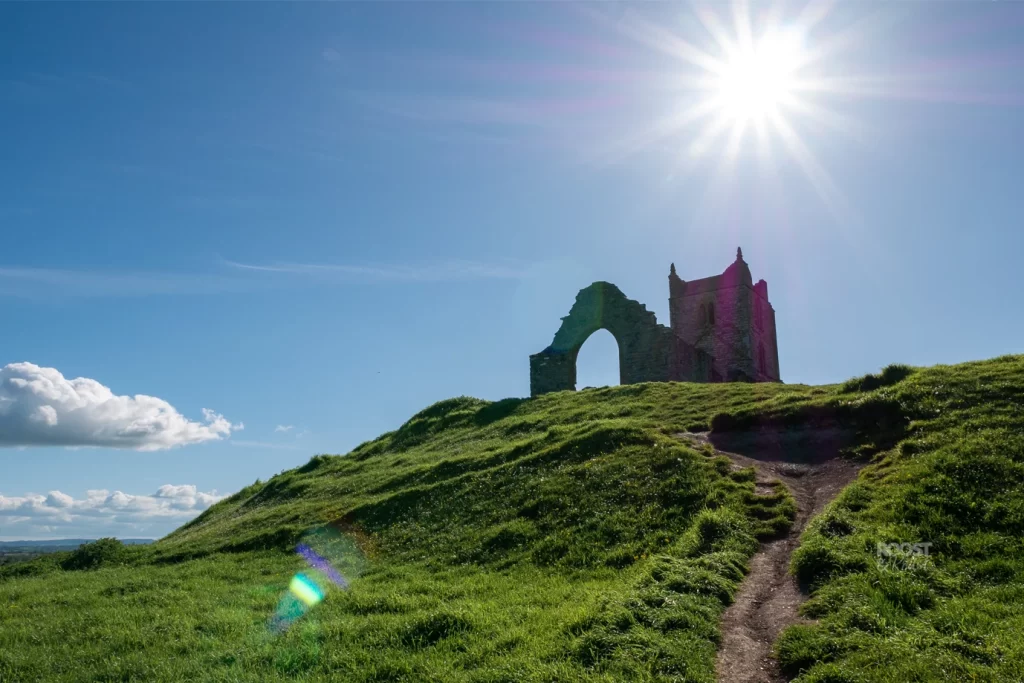
Did Burrow Mump have a purpose?
Before the St.Michaels Church, a medieval church sat in its place during the 15th century. If we travel even further back in time, it’s likely a Norman motte and bailey could have once stood here. Archaeologists have also excavated Roman pottery and coins nearby. Which presents the possibility that this site was once used as a handy lookout spot, or maybe even a trading post. Thanks to its raised elevation and close location to the river junction (where the River Cary and River Tone join the River Parrett), you can understand why they have arrived at that conclusion.
Legend has it that King Alfred used Burrow Mump as a look out tower to spot the Danes coming to attack. After all, it’s not far from the Isle of Athelney where he hid in the marshes, gathered an army…and burnt the cake!
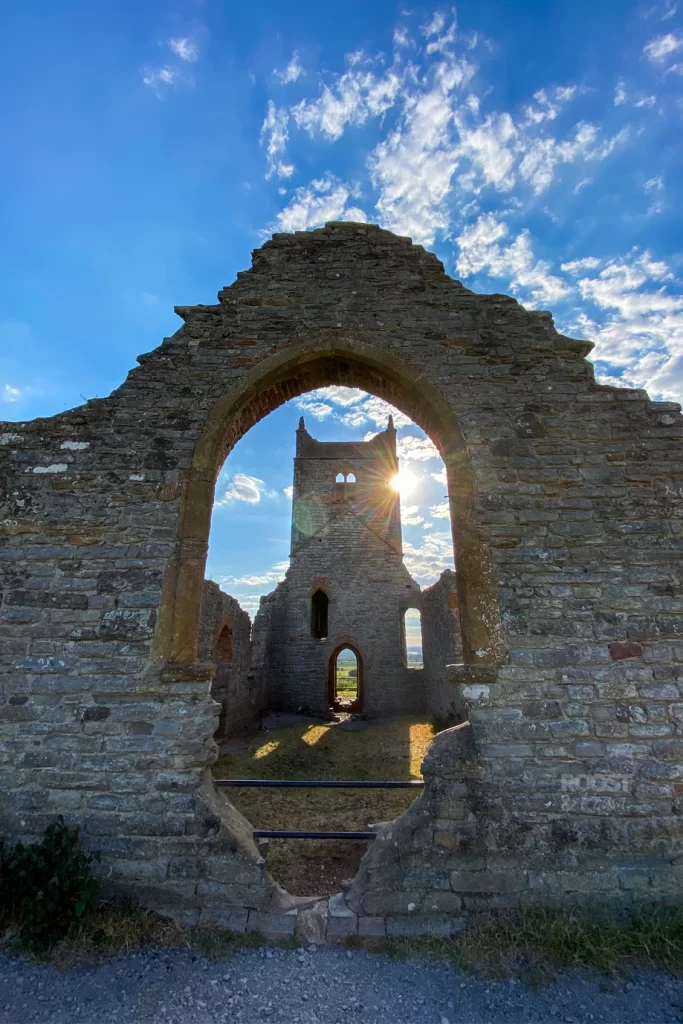
Where is the Isle of Athelney?
The Isle of Athelney (which means ‘The Island of Princes’) was located between the villages of Burrowbridge (where Burrow Mump is) and East Lyng. It was here where King Alfred The Great founded Athelney abbey in the year 888, as a way of giving thanks to the locals for helping him. Today, nothing above ground remains of this ancient settlement, as it was destroyed in 1539 under King Henry VIII’s dissolution of monasteries. The resulting pile of torn-down rubble was valued at £80. Thats around £35,000 in todays money!
Do you remember the TV show ‘Time Team’? They visited the Isle of Athelney on their first ever episode, then returned on their 100th episode to head beneath the soil. The excavations uncovered intricate floor tiles from the grand abbey, skeletons were found too. But it also revealed that this site is one of the only known Anglo-Saxon metalworking sites in the UK!
If you attend The Isle of Athelney today, (now a village called Athelney) all you will find is a small, and slightly underwhelming monument that marks the location of where this important monastery once stood.
The monument is about a 5 minute drive away from Burrow Mump. It’s on private farmland, but theres a permissive footpath to reach the monument.

Why does Burrow Mump have ripples?
Much like Glastonbury Tor, the low laying land that surrounds the hill is prone to harsh flooding during the winter months. Although, a long time ago, Burrow Mump would have been an island surrounded by a marshy-sea. So archaeologists believe the ringed ripples on the hill were used for agricultural purposes during the medieval period.
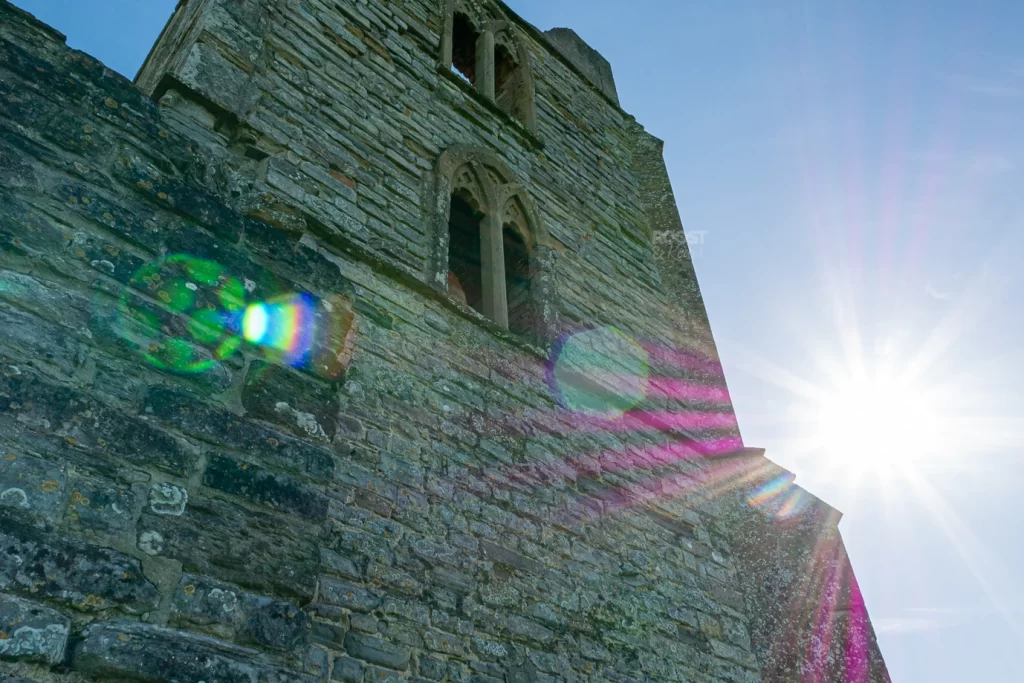
How high is Burrow Mump?
This natural hill is only 24 meters (79ft) high. Hardly towering, but because the surrounding land is so flat you get to experience incredible panoramic views from the top. As the Burrow Mump hill consists of Triassic Sandstone, it means that it was formed somewhere around 250 million years ago!
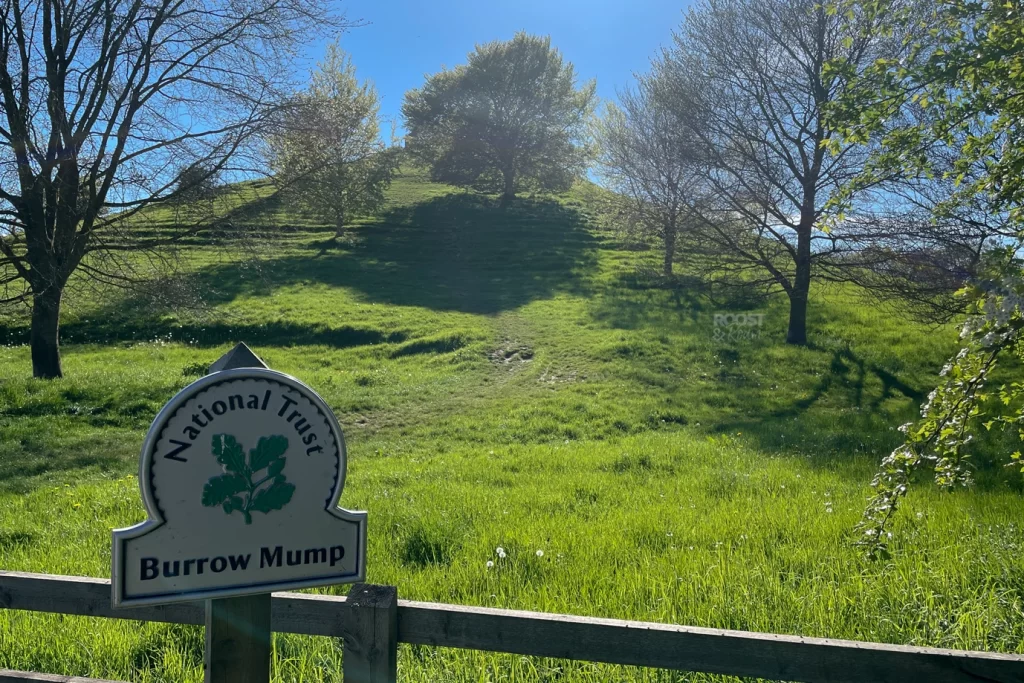
What does Burrow Mump mean?
In Olde English, the words ‘burrow’ and ‘mump’ both mean hill. Which means Borrow Mump is really named Hill Hill! It must have taken them a really, really long time to put that name together!
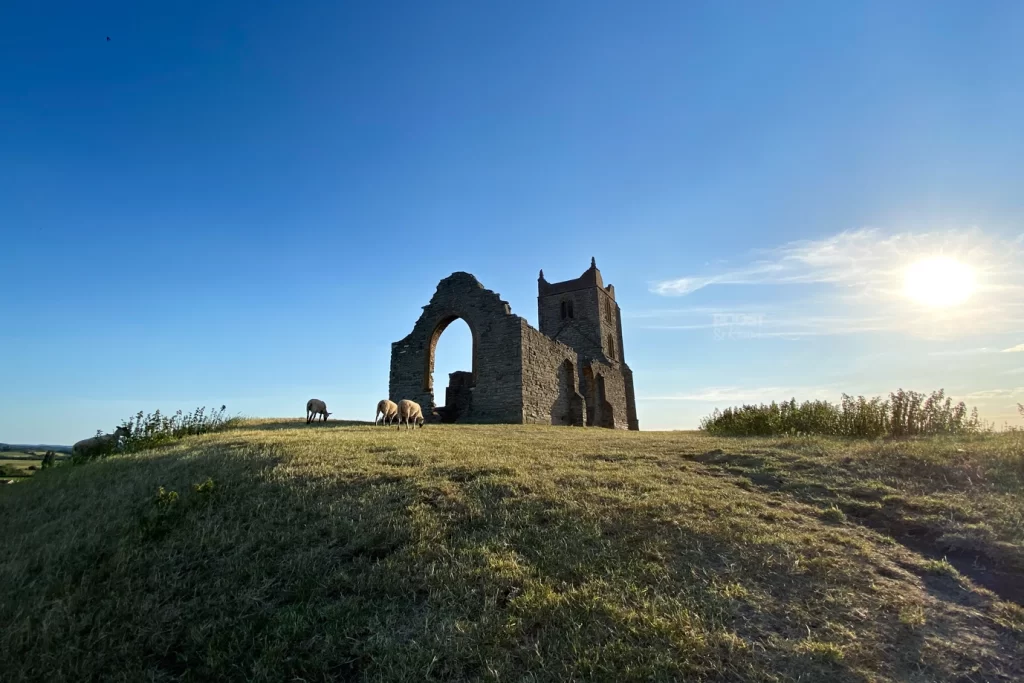
Is Burrow Mump worth visiting?
Although Burrow Mump is on a far smaller scale then Glastonbury Tor, and brings less crowds. It’s no less worthy of a visit! The ruin is incredibly photogenic. Especially when the sun is low, casting a golden glow over the old stone tower and detailed window arches. Even though Burrow Mump’s not that high, it offers extensive views over the beautiful Somerset levels.
This historic church and hill has plenty of history and stories regarding the Saxon King Alfred. But, to gain a better perspective of how it would have looked hundreds of years ago. Come during the flooded winter months when it appears more like an island. Then take a glimpse through the same lens as King Alfred possibly did.
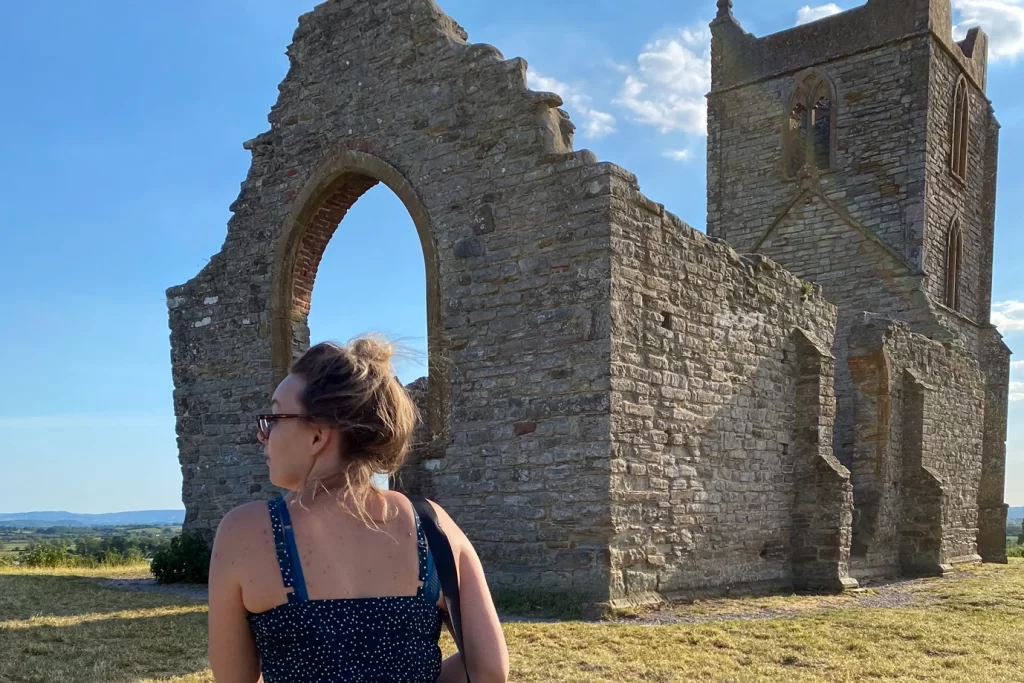
Places to eat
To cheer up any rumbling tummies, at the base of the hill you’ll find the aptly named King Alfred pub. It sits right beside the river bank and offers traditional English pub grub. The type that doesn’t do portions by halves.
They also have different themed nights throughout the month, offering flavours and cuisines from across the globe. The King Alfred pub has a good sized carpark, and a glorious outdoor area to enjoy a refreshing local cider in the summer.
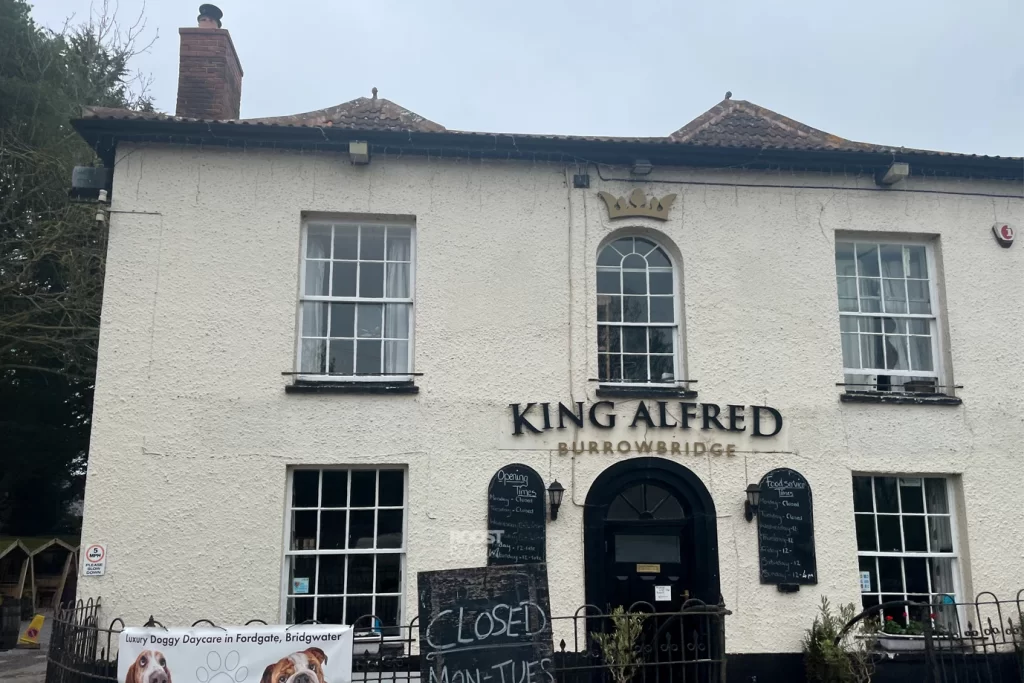
Where did King Alfred burn the cake?
Ever since I was little, I’ve been told the story that Burrow Mump is where King Alfred famously burnt the cake! Although, this supposedly happened just down the road at the Isle of Athelney.
Unlike today, England was made up of four kingdoms: East Anglia, Mercia, Northumbria, and Wessex. It was only the latter which the Vikings hadn’t yet overruled. In the year 877, at his base in Chippenham, the Vikings launched a surprise attack. Forcing King Alfred to flee to the Somerset levels with only a few of his army. He spent weeks in disguise, living life as a hunted man, hiding in the safety of the impassable marshes at the Isle of Athelney. A place he knew well from his childhood. This move left him fully dependant on the kindness and generosity of locals for food and shelter, which is where this famous story begins! One day King Alfred took refuge in a swineherd’s cottage, where the pig farmers wife asked him to supervise her griddle cakes. Too distracted from the fact his kingdom was at war with the Vikings, he accidentally let the small loaves of bread burn beside the fire.
Apparently the women was furious with him for burning her griddle cakes! Completely unaware of his royal status, and in a frenzy. She scalded King Alfred and beat him with her wooden broomstick.
This brilliant old English tale is part of Great Britain’s mythology. Plus, it’s most likely the story we all know about King Alfred the Great! To be honest, theres no real knowing if this story is fact or fiction. Mainly because the first surviving mention of this famous story is found years after the event supposedly happened. In a book that was put together sometime in the late 10th century.
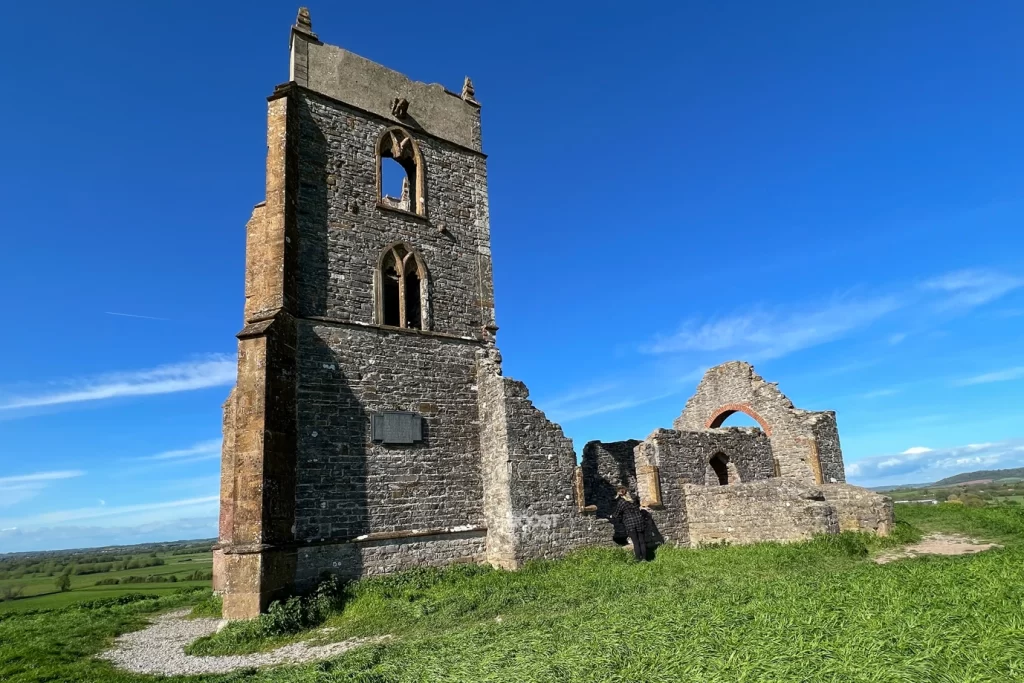
Where to park?
At the base of Burrow Mump hill, you’ll find a carpark with perhaps enough space for around 20 cars. That’s if people park sensibly! The carpark is free, but there is a donations box if you’re feeling generous.
We’ve never not managed to get a space here, as this site doesn’t bring the hordes of tourists like Glastonbury tour does!
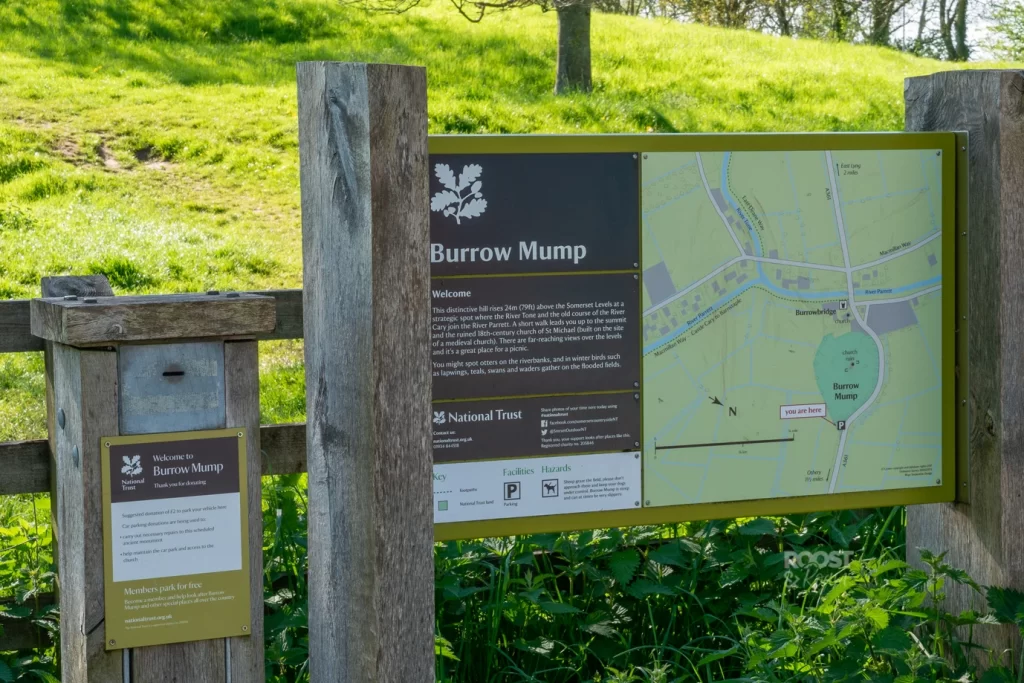
How hard is it to walk up Burrow Mump?
From the carpark the walk up Burrow Mump is short but steep, and there is no official path here. It’s just a trodden route from centuries of people trudging their way up the mound.
As there is no path it’s probably not the most ideal for anyone suffering with mobility issues. The grassy route can become muddy & slippery if its rained, so you’ll need some grippy walking boots for the best traction.
Although it’s steep, it’s only a short stomp up the hill… less than 5 minutes! So I would say it’s accessible to most.
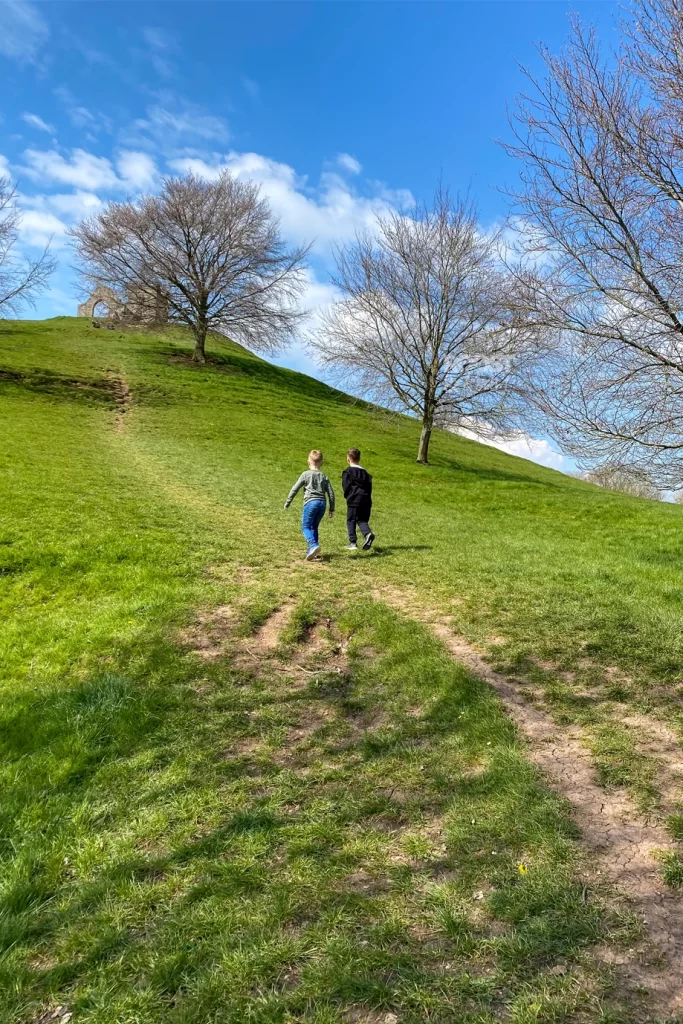
Are there any toilets?
There are no toilets here, or any shops to get refreshments. Your nearest option would be the King Alfred pub in Burrowbridge.

Places to visit nearby
Other than going to see the Isle of Athelney monument which is a short 5 minute drive away. Glastonbury Tor is about 12 miles away, although expect bigger crowds of people there. Afterwards, you can enjoy wandering around the colourful town.
There’s also the stunning Cheddar Gorge which is 20 miles away. There you will be able to experience some incredible walks, and take an epic drive through England’s largest gorge!
Accommodation near Burrow Mump
Burrowbridge is only small so you wont find any hotels there, but you might get lucky with an Airbnb in the nearby villages. Otherwise your closest (and plentiful) options are going to be in Taunton, Bridgwater or Glastonbury.
